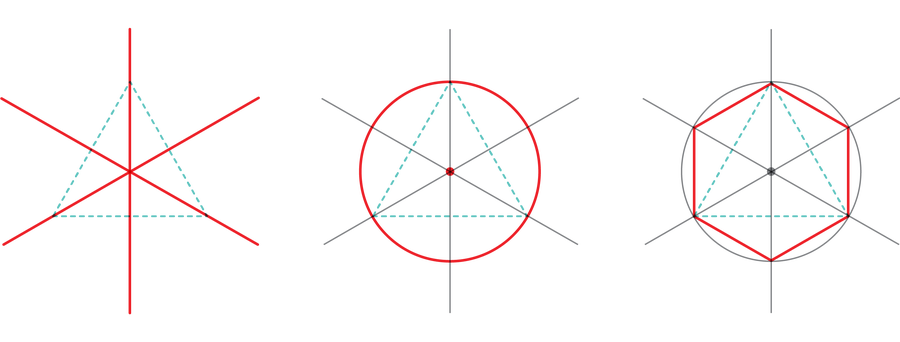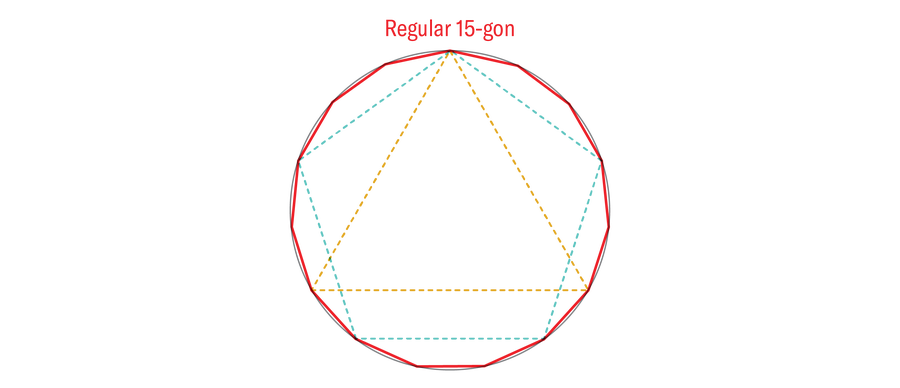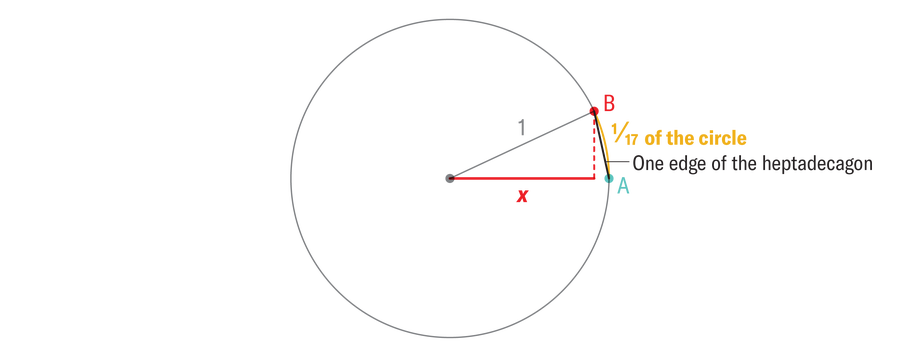If you had to choose a few words or symbols to encapsulate your legacy, what would you pick? Johann Carl Friedrich Gauss (1777–1855) left behind a trophy case stocked with mathematical achievements to choose from, but above all, he wanted a “regular heptadecagon” etched on his headstone. The highly symmetrical 17-sided shape starred in a proof that Gauss considered one of his greatest contributions to math. At just 18 years old Gauss used a heptadecagon to solve a classic problem that had stumped mathematicians for more than 2,000 years. A tour through that history reveals deep connections between the ancient conception of shapes as drawings and a modern perspective of the equations that govern them.
Ancient Greek Geometry
The ancient Greeks excelled at geometry, placing special emphasis on constructions created with a compass and straightedge. Think of these constructions as diagrams with desired geometric properties created solely with a writing utensil and two tools. Given two points, a compass (not to be confused with the navigational device) draws a circle centered at either point that passes through the other point. A straightedge draws straight lines between the points. Neither tool has any markings on it, so they cannot measure distances or angles.
On supporting science journalism
If you’re enjoying this article, consider supporting our award-winning journalism by subscribing. By purchasing a subscription you are helping to ensure the future of impactful stories about the discoveries and ideas shaping our world today.
The Greeks didn’t impose arbitrary rules just to make math more challenging. The game of constructing shapes with a compass and straightedge originates in Euclid’s Elements, one of the most important textbooks ever written. Like modern mathematicians, Euclid set out to derive all of geometry from a minimal list of assumptions called postulates. Instead of merely asserting the existence of shapes or other geometric objects, Euclid wanted to build them explicitly from the simplest ingredients: lines and circles.
To get a feel for these constructions, try one for yourself. Given the line segment from A to B below, find its midpoint. Eyeballing won’t suffice; your method must find the exact midpoint.
First use the compass to draw a circle centered at A and passing through B (first panel). Then repeat this step with the circle centered at B and passing through A (second panel). These circles intersect at two points. Use the straightedge to connect these points (third panel). By the symmetry in our construction, this vertical line will intersect the original line segment exactly at its midpoint.

This construction does much more than bisect a line segment. It creates a right angle between the two lines, which is not a trivial feat with such a restricted tool set. And by connecting a few more points, you can make an equilateral triangle—one whose sides have equal lengths (and whose angles have equal measure).

Notice that each edge of the triangle is also a radius of one of the circles. The circles are the same size and therefore all the triangle’s sides have the same length. So equilateral triangles are constructible with a compass and straightedge, QED. Congratulations on persisting through the first proposition in the first book of Euclid’s Elements. Only 13 more books to go.
A Roadblock
Of all the shapes that one can construct with a compass and straightedge, regular polygons hold a special cachet. Polygons are enclosed shapes composed of straight-line edges, such as triangles and rectangles (as opposed to curved shapes such as circles or unenclosed shapes such as the letter E). Regular polygons have the most symmetry in that their sides all have equal length and their angles all have equal measure (like squares and equilateral triangles but unlike rectangles and rhombuses). Constructing any old irregular triangle with a compass and straightedge is child’s play—just scatter three points on the page and connect them with lines. But constructing our perfectly symmetric equilateral triangle—a regular polygon—required some elegant legwork.
Euclid figured out how to construct regular polygons with three, four and five sides—or equilateral triangles, squares and regular pentagons, respectively. He squeezed a few more generalizations out of these core constructions; for instance, once you have a regular polygon on the page, a simple maneuver will produce a new regular polygon with double the number of sides.

You can repeat this doubling procedure as many times as you wish. That means three-, four- and five-sided regular polygons can be transformed into six-, eight- and 10-sided regular polygons, as well as 12-, 16- and 20-sided ones, and so on. Euclid also showed how to “multiply” the three- and five-sided regular polygons to produce a regular 15-gon.

Progress halted there. Somehow Euclid knew that a regular 3,072-gon was constructible in principle (a triangle doubled 10 times), but he had no idea how to construct a regular seven-gon (heptagon) or 11-gon (hendecagon). To be clear, regular polygons of any number of sides greater than two do exist and can be constructed with more capable tools. The question that Euclid left behind asks which ones are constructible with a compass and straightedge alone. This question would remain unanswered for two millennia until a certain German teenager picked up a pencil.
18th-Century Math to the Rescue
By 1796 no new regular polygons had joined the pantheon of constructible shapes, yet mathematicians had acquired a deeper understanding of compass and straightedge constructions. Gauss knew how to reduce the problem of constructing a regular polygon to that of merely constructing a line segment with a very specific length. To see how to create a 17-gon, start with a unit circle (where the radius equals one) and a point A on the circle. Imagine we could find the red point B above A exactly one seventeenth of the way around the circle. If we could construct the red point from the blue point, we could repeat that construction all the way around the circle, connect the dots with our straightedge, and voilà, a regular heptadecagon. How do we draw point B, given point A, though? Notice that if we could draw the red line segment labeled x, then we can trace that up to the red point B, and we win. The entire problem of constructing a regular heptadecagon boils down to constructing a line segment with the precise length x. For the mathematically curious, x = cosine (2π ⁄17).

Can a compass and straightedge construct a line segment of any length? By Gauss’s time, mathematicians knew the surprising answer to this question. A length is constructible exactly when it can be expressed with the operations of addition, subtraction, multiplication, division or square roots applied to integers. So some strange numbers such as the square root of 99⁄5 are constructible (99 and 5 are integers, and we’ve applied division and square root to them), whereas some more familiar numbers such as pi (π) and the cube root of 2 cannot be constructed because one can never write them in terms of these five operations alone.
Remarkably, the rudimentary tools that the ancient Greeks used to draw their geometric diagrams perfectly match the natural operations of modern-day algebra: addition (+), subtraction (–), multiplication (x), division (/) and taking square roots (√). The reason stems from the fact that the equations for lines and circles only use these five operations, a perspective that Euclid couldn’t have envisioned in the prealgebra age.
It might surprise you to learn that Gauss never actually drew a regular heptadecagon. He didn’t need to. He proved that the shape is constructible in principle by expressing the special length x [cosine (2π ⁄17)] solely in terms of the five algebraic operations that the compass and straightedge permit. Even if you don’t find his equation particularly enlightening, its complexity demonstrates how much work the adolescent must have poured into the problem:

Even more impressive, Gauss fully characterized which regular polygons are constructible and which aren’t (although it was not until 1837 that Pierre Wantzel provided a rigorous proof that Gauss’s characterization didn’t leave out anything). So not only did Gauss describe the form that all constructible regular polygons take, he and Wantzel vindicated Euclid’s frustrations by proving that the elusive regular heptagon (seven sides) and hendecagon (11 sides) are impossible to construct with a compass and straightedge alone, along with infinitely many other shapes.
According to biographer G. Waldo Dunnington, Gauss felt great pride in cracking the millennia-old problem and told a friend that he wanted a regular heptadecagon displayed on his headstone. Sadly, this didn’t happen, but a monument in Gauss’s birth city of Brunswick, Germany, boasts a 17-pointed star engraved on the back. The stonemason chose a star because he believed that people couldn’t distinguish a heptadecagon from a circle. I wonder if Euclid would agree.

